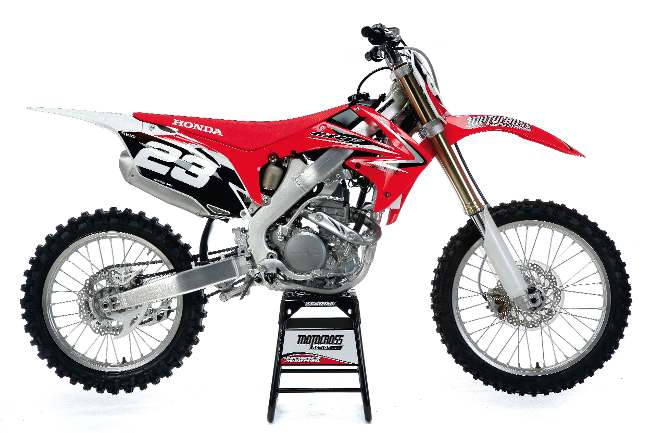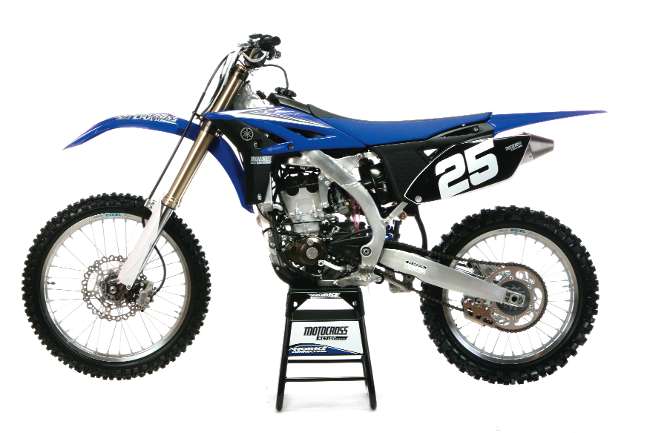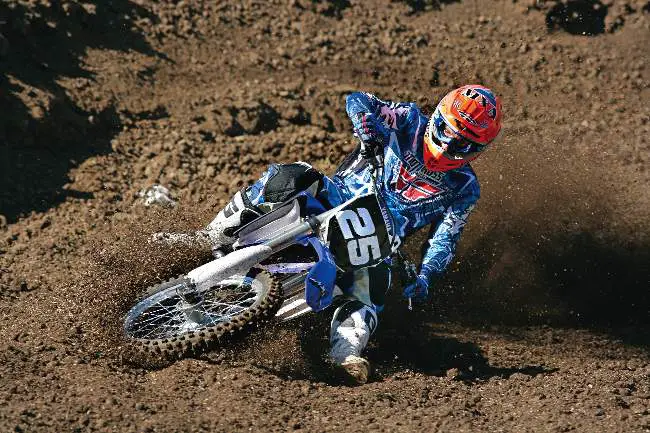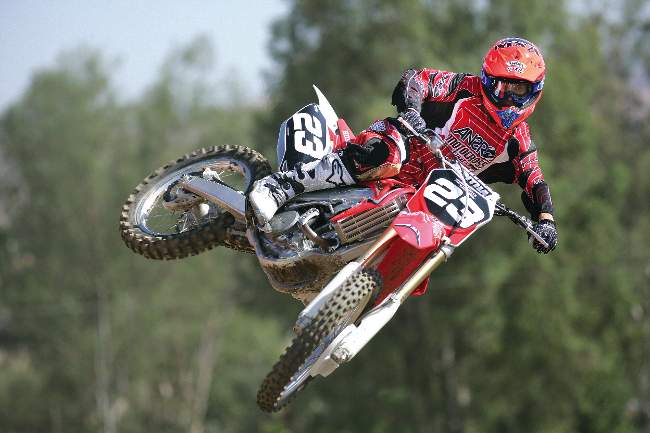REAL TESTS! 2010 MXA 250 SHOOTOUT: HONDA CRF250 VS. YAMAHA YZ250F:

This is a shootout between the two best-selling 250 four-strokes in America. The Yamaha YZ250F and Honda CRF250 are available in over 3000 dealerships across the land. One of them (the Honda CRF250) won last year’s MXA Shootout, while the other (the Yamaha YZ250F) finished third. The MXA wrecking crew wanted to know how these two machines would rank against each other after a winter of hardcore R&D.

WHICH BIKE HAS THE BEST ALL-AROUND POWERBAND?
(1) Honda. If Honda had stuck with the 2009 engine, we would be raving about the 2010 CRF250…but we aren’t. Why? Every single test rider felt that the 2010 CRF250 lacked the hit and snap of the 2009 model. The 2010 engine is still fast, largely in the midrange, but it doesn’t have the broad powerband and versatility of last year’s engine. This is a midrange engine, which means that it isn’t all that great down low or on top. But, even with these limitations, every MXA test rider preferred it over the 2010 Yamaha YZ250F powerband.
(2) Yamaha. Directly off the bottom, the 2010 engine is much stronger than the 2010 Honda CRF250. The new YZ250F engine pulls very hard. Unfortunately, it pulls for a very short period of time. This is a low-to-mid powerband (and many MXA test riders called it a “low-to-low” powerband). The 2010 YZ250F is awesome off the bottom, but mediocre across the top. It is a one-dimensional powerband.

WHICH BIKE IS BETTER ON THE DYNO?
(1) Honda. On the dyno, the 2010 CRF250 reaches 36.37 horsepower at 10,900 rpm with maximum torque of 19.18 foot-pounds. That may sound good, but the 2009 CRF250 reached 37.02 horsepower with 19.28 foot-pounds of torque. Compared to the 2010 Yamaha YZ250F, the Honda CRF250 is weak down low and equally flat on top. Where the Honda shines in comparison to the YZ250F is from 9000 rpm to 11,500 rpm. However, it is misleading to think that the Honda pulls across that 2500 rpm range, because it doesn’t. The CRF250 engine is flat after 10,500 rpm. In a nutshell, the 2010 CRF250 makes its best power dead center in the powerband (from 9000 to 10,500). It doesn’t offer much above or below that. Still, every MXA test rider liked the Honda’s midrange powerband more than the Yamaha’s low-end powerband.
(2) Yamaha. Maximum horsepower on our 2010 YZ250F was 35.88 ponies at 11,700 rpm, but that high rpm peak is very misleading. For comparison, the 2010 Honda made about a half horsepower more. In a nutshell, the YZ250F produces more power or matches the horsepower of the 2010 CRF250 from 6000 rpm to 9000 rpm. After 9000 rpm, the CRF250 makes more power until their two respective dyno curves meet again at 11,500 rpm? but neither bike has any discernible top-end power. The 2010 YZ250F is a burst engine. It makes great power from low-to-mid and then runs flat into the top end. Maximum torque of the 2010 YZ250F was 18.95 foot-pounds.

WHICH BIKE HANDLES THE BEST?
(1) Yamaha. Yamaha’s engineers have always striven to stay in the middle of the road. They don’t want to risk having a bike that turns sharply but shakes in the fast stuff (or is rock solid at speed but refuses to turn). The 2010 YZ250F is still a middle-of-the-road chassis, but thanks to a flatter saddle and all-new geometry, this is the best handling YZ250F in years. It is much better than the 2010 Honda CRF250 in virtually every aspect (from stability to cornering).
(2) Honda. Yikes! We thought that Honda would have learned some valuable lessons about handling with the mistakes they made on their 2009 CRF450 chassis, but they didn’t. The CRF250 oversteers, head shakes, stinkbugs, wanders and hunts-and-pecks. What’s left? In stock trim, without stiffer fork springs, MXA test riders started wearing three St. Christopher medals during each race.

WHICH BIKE HAS THE BEST SUSPENSION?
(1) Yamaha. In stock trim, the YZ250F’s Kayaba suspension isn’t very well-balanced. The shock feels high in its stroke, and the front forks hit a shelf of excessive compression damping about two-thirds of the way through their stroke. There are two fixes. (1) For fast or heavy riders, put in stiffer fork springs and lower the oil height by 20mm. (2) For lighter or slower riders, leave the stock fork springs in, but lower the oil height by 10mm. Yamaha wins this category in spite of the need to fiddle with the forks, because the Honda has worse issues.
(2) Honda. The forks are undersprung, and the shock sits high in the rear, creating a stinkbug stance. Every test rider, regardless of his weight or skill level, felt that the forks were way too soft. And that softness, combined with the very steep frame geometry, only loaded the front end more. The shock spring seems about right for an average-sized rider, but the forks are too soft.
WHICH BIKE HAS THE BEST BRAKES?
(1) Yamaha. We aren’t going to rave about the Yamaha YZ250F brakes, but they are workmanlike. The front has a nice feel at the lever, and the rear pedal is adjustable across a wide range. They aren’t powerful brakes, but they are predictable.
HOW WOULD THE MXA TEST CREW DESCRIBE EACH BIKE?
(1) Yamaha. We are pretty sure that the fancy perimeter frame, new triple clamp offset and “arrow styling” were designed to be used with an all-new fuel-injected YZ250F engine. When release of the fuel-injected engine was delayed, Yamaha stuck a revised version of the old YZ250F powerplant in a new dress and sent it to the prom. The only problem? The engine has two left feet.
(2) Honda CRF250. We’d have to say that the 2010 Honda CRF250 is one step forward and two steps backwards. The engine and handling don’t hold a candle to the 2009 Honda CRF250. Paradoxically, where last year’s CRF250 forks were harsh beyond belief, this year’s forks are soft beyond belief. The best compliment we can pay to the 2010 CRF250 is that it no longer has jetting issues.
WHICH BIKE WINS THIS SHOOTOUT?
(1) Yamaha. Every MXA test rider would rather race the 2010 YZ250F (thanks to the chassis and suspension) than hang on to the weirdly configured geometry on the 2010 CRF250. On the other hand, not a single MXA test rider liked the Yamaha’s short, abrupt, low-to-mid powerband. However, it’s easier to make a slow bike fast than to make a poor-handling bike calm down.
(2) Honda. If this were a shootout between four bikes, the 2009 YZ250F, 2009 CRF250, 2010 YZ250F and 2010 CRF250, the 2010 Honda CRF250 would come in fourth (just so you know, the 2009 Honda CRF250 would win). As it sits, the 2010 Honda CRF250 needs another year of development work back at the factory.
MXA’S RECOMMENDED CRF250 SETTINGS
2010 HONDA CRF250 JETTING
Throttle body: Keihin 50mm
Injector: 12-hole
Injector size: 60 micron
Fuel pump/pressure: Electric/50 psi
Fuel map: Adjustable (with optional tool)
Idle: 60 clicks out
Notes: The idle clicker is the choke knob. It can be pulled out and clicked out (counter-clockwise) to increase idle speed. It was really designed as an air/fuel control, not an idle screw.
2010 HONDA CRF250 FORK SETTINGS
Spring rate: 0.46 kg/mm (0.45 kg/mm stock)
Oil height: 342cc
Compression: 8 clicks out
Rebound: 8 clicks out
Fork leg height: Flush with top clamp
Notes: The 48mm Showa forks come with a separate aluminum screw on top of the fork legs. Do not use it to bleed air out of the forks. It is only to be unscrewed when servicing the forks. Use the brass screw to bleed the forks. Any rider who is fast or slightly heavy will benefit from stiffer 0.46 fork springs.
2010 HONDA CRF250 SHOCK SETTINGS
Spring rate: 5.3 kg/mm
Race sag: 105mm
Hi-compression: 1-1/16 turns out
Lo-compression: 7 clicks out
Rebound: 10 clicks out
Notes: The shock is sensitive to high-speed compression settings. Heavier riders should go in a quarter turn on the high-speed compression and set the sag at 100mm.
MXA’S RECOMMENDED YAMAHA YZ250F SETTINGS
2010 YAMAHA YZ250F JETTING
Main: 180
Pilot: 45
Needle: NDJR
Clip position: 4th from top
Fuel screw: 3/4 turns out
Leak jet: 70
Notes: Yamaha’s initial literature listed the fuel screw at 2-1/4 turns out, but Yamaha changed the fuel screw to 1-3/4 turns out for production. The needle is richer by a half clip compared to the 2009 needle. For high altitude, we recommend switching to a 178 mainjet with the clip in the third position. For cold weather, we recommend swapping the 180 mainjet for a 182 and adjusting the fuel screw to 2-1/4 turns out.
2010 YAMAHA YZ250F FORK SETTINGS
Spring rate: 0.46 kg/mm (0.45 kg/mm stock)
Oil quantity: 350cc
Compression: 10 clicks out
Rebound: 10 clicks out
Fork leg height: 5mm up
Notes: Slower and smaller riders can get away with using the stock 0.45 kg/mm fork spring rate, but might want to lower the oil height by 10mm. Heavier or faster riders need to switch to the heavier 0.46 spring rate and lower the oil height by 20mm.
2010 YAMAHA YZ250F SHOCK SETTINGS
Spring rate: 5.3 kg/mm
Race sag: 105mm
Hi-compression: 2-1/4 turns out
Lo-compression: 7 clicks out
Rebound: 9 clicks out
Notes: Riders who haven’t switched to heavier-weight fork springs should run upwards of 105mm of race sag.






Comments are closed.